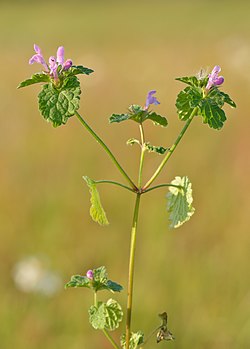| Lamium | |
|---|---|
 | |
| Lamium amplexicaule | |
| Scientific classification | |
| Kingdom: | Plantae |
| Clade: | Tracheophytes |
| Clade: | Angiosperms |
| Clade: | Eudicots |
| Clade: | Asterids |
| Order: | Lamiales |
| Family: | Lamiaceae |
| Subfamily: | Lamioideae |
| Genus: | Lamium L. [1] |
| Type species | |
| Lamium purpureum L. | |
| Synonyms [2] | |
| |
Lamium (dead-nettles) is a genus of about 30 species of flowering plants in the family Lamiaceae, of which it is the type genus. They are all herbaceous plants native to Eurasia and northern Africa, with several widely naturalised across much of the temperate world.
